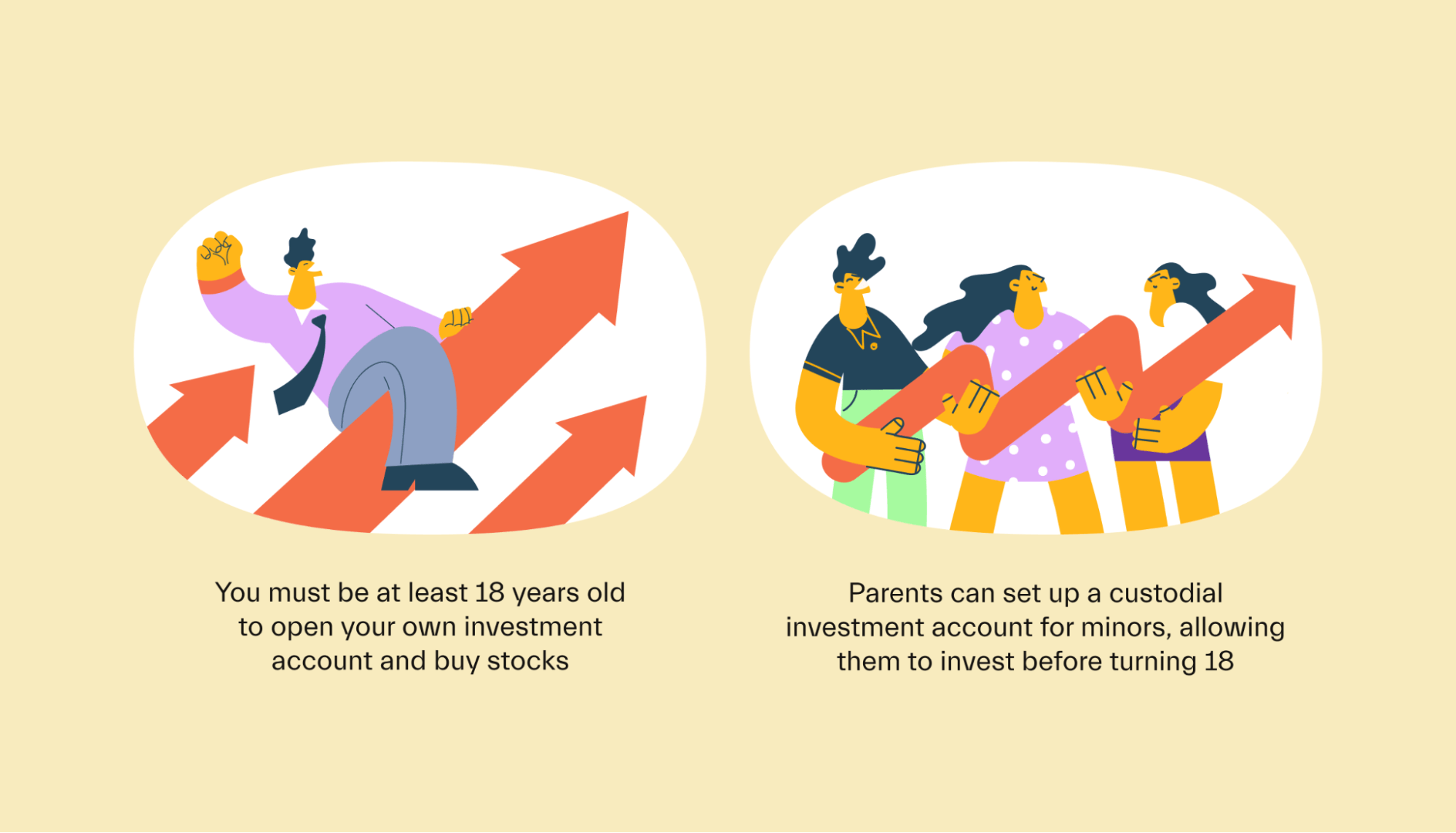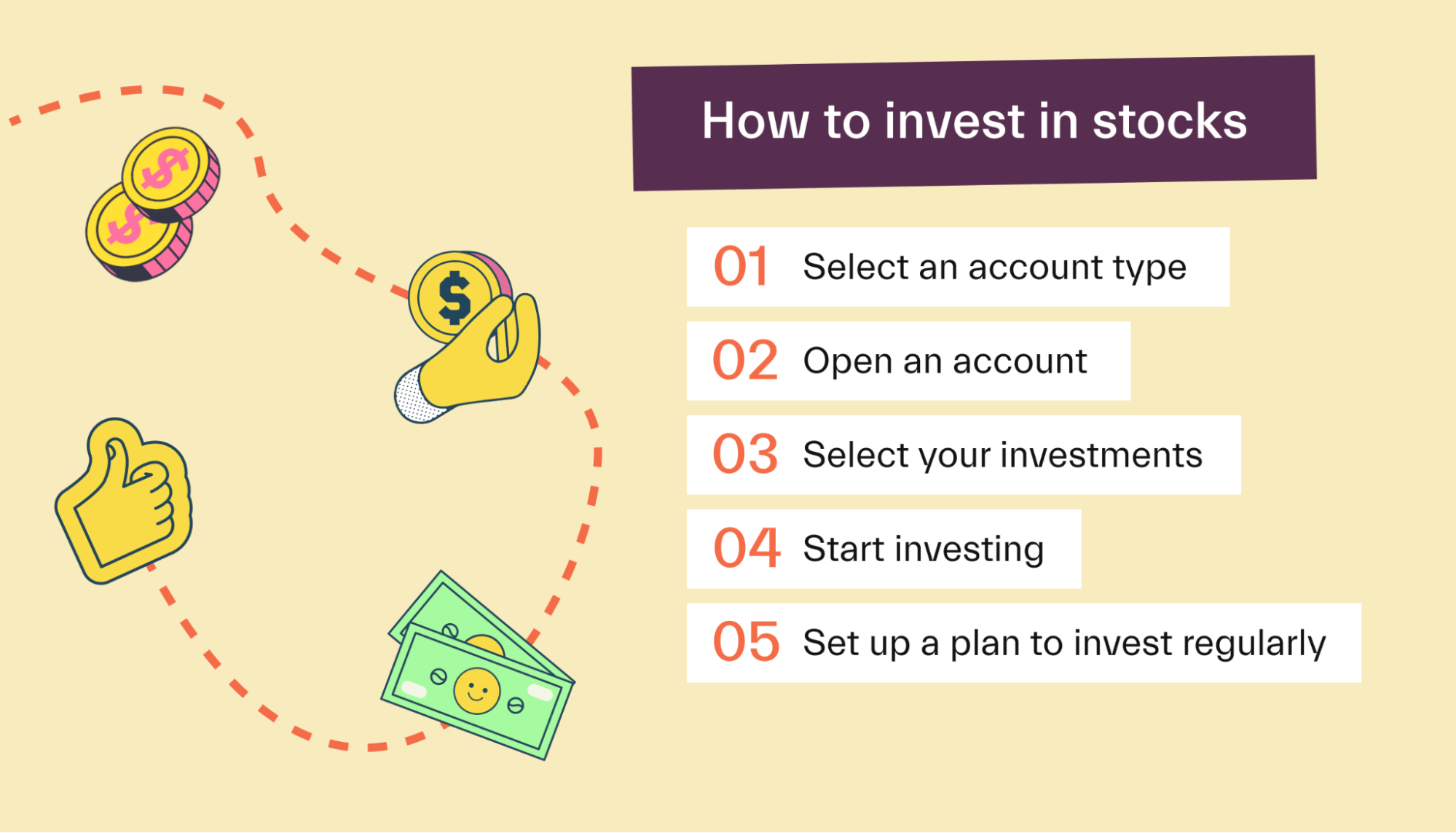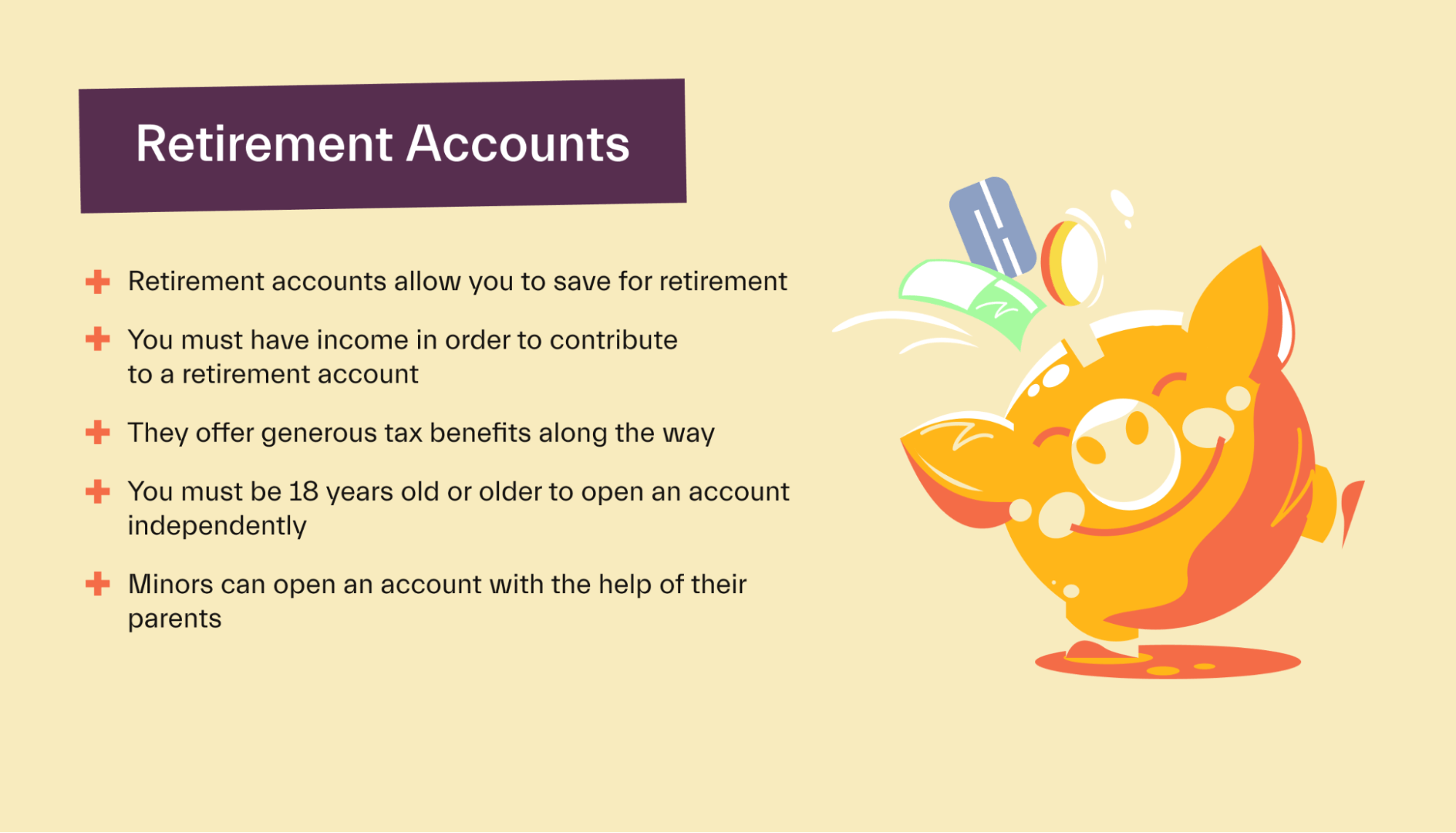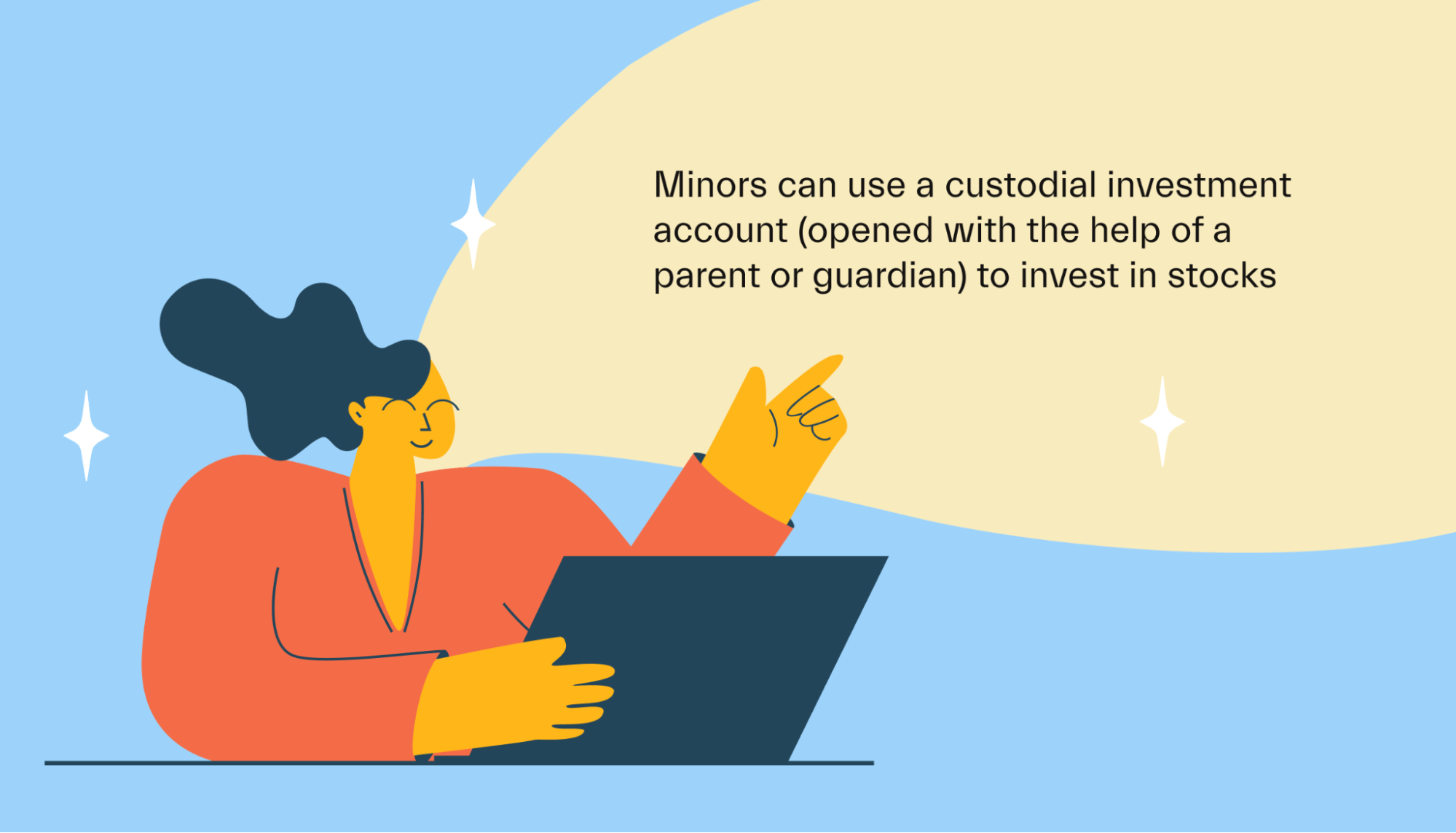Investing •
At what age can you invest in stocks?
Learn more about what age you can get started investing in stocks and what to do if you’re under 18.

This article is for informational purposes only and should not be considered financial or investment advice.
Investing in the stock market is a great way to build wealth long term.
Stocks represent fractional ownership of companies. For instance, if you own Amazon stock, you technically own a very small piece of Amazon!
As the company grows, so does the value of your stock. Over time, this can lead to significant wealth creation.
And the earlier you can get started, the better. But how old do you have to be to invest in stocks?
At what age can you invest in stocks?
You must be at least 18 years old to open your own account and invest in stocks. However, there are ways around this rule that allow minors to invest with the help of a parent or guardian.

To invest in stocks, you need a stock brokerage account. This account will give you access to the stock market, where shares of publicly-traded companies are exchanged. These accounts are available from companies like Fidelity, Schwab, and Vanguard. All standard brokerage accounts have a minimum age requirement of 18.
Fortunately, there’s a special type of account called a custodial investment account. This type of account has 2 account holders: the beneficiary and the custodian.
The custodian must be at least 18 years old, and they’re the one who actually opens the account and manages it. The beneficiary can be under 18, but, though they technically own the account, they don’t directly control it.
The custodian remains in control of the account until the beneficiary turns 18, at which point the beneficiary can sell the assets or take over the management of the account.
Parents and guardians often serve as the account custodian—although technically, any legal adult can be a custodian. So a grandparent or even a family friend could open a custodial account on behalf of a minor.
Key takeaway: An individual must be at least 18 to open their own brokerage account and buy stocks, but an adult can help set up a custodial investment account on a minor’s behalf.
How to invest in stocks
Investing in stocks doesn’t need to be complicated, but it can certainly seem intimidating for new investors! Here’s what you need to know.

There are 5 basic steps to start investing in stocks:
1. Select an account type
There are several different types of investment accounts that you can open, including:
Standard brokerage accounts, which are the “vanilla” account type and offer no tax benefits (but also no restrictions on deposits or withdrawals)
Retirement accounts, which offer tax benefits if you save for retirement
Education accounts, like 529 plans, which offer tax benefits if you save for education
Custodial accounts, which allow minors to start investing before turning 18
If you’re just getting started (and you’re over 18), a standard brokerage account is a good option. Retirement accounts are also beneficial, but they have more restrictions and rules.
2. Open an account
Once you’ve decided which account type to use, you need to choose where to open it. You can open any of the accounts listed above with a reputable broker, such as Vanguard, Fidelity, or Schwab.
Some account types are also offered by newer investment apps, like Robinhood or Webull. These apps are simple to use but usually have fewer advanced features and a limited selection of accounts/investments.
After selecting the broker you want to use, you can open an account following their instructions. Brokers require a fair amount of information to open an account, but it shouldn’t take long. You’ll need to provide your:
Name
Address
Social security number
Annual income
Email and phone number
Driver’s license or other government-issued photo ID
Employment status
The broker uses this information to verify your identity and set up tax reporting.
3. Select your investments
Next, it’s time to decide what type of stocks you actually want to buy. We’ll discuss this more in the section below, but the 2 main categories are:
Individual stocks, like Amazon or McDonald’s. Investing in individual stocks tends to be a bit riskier and requires more research.
Stock index funds, like the S&P 500. These funds invest in hundreds of stocks at once, which spreads out your risk.
If you’re brand new and just want to get started, choosing an index fund is a great starting point.
4. Start investing
Now it’s time to pull the trigger and actually buy something! If you haven’t already, you’ll need to transfer the funds from your bank account. Once you have them deposited in your investment account, you can start buying.
To buy stocks, you must place a buy order. To do this, you simply type in the name of the stock you want to buy, the number of shares you want (or the dollar amount you want to spend), and the order type.
For beginners, using the “market” order is simplest. This means that the trade will go through at the current market price of the stock. If you place a “market” buy order for 10 shares of stock XYZ, and XYZ is trading for $11 per share, the buy order will be fulfilled at $11 per share ($110 total).
You can also set a “limit” order, which allows you to set the price you want to pay. For example, you could say you want to buy 10 shares of XYZ at $9 per share. In this case, the order won’t go through unless XYZ starts trading at $9 or less per share.
Stock trading occurs during set trading hours, from 9:30 am to 4 pm. ET. If you place an order outside of these hours, your trade will go through on the next trading day.
5. Set up a plan to invest regularly
Getting started with your first stocks is exciting! But building real wealth requires a long-term commitment to regularly investing.
It’s wise to set up an automatic transfer to your investment account on a monthly basis. That way, you can automate your investments and build wealth passively.
It doesn’t take a big monthly investment to end up with a lot of cash over time. If you invest just $100 per month for 30 years and earn 10% returns, you’ll wind up with over $208,000!
What should I invest in?
There are literally thousands of companies that you can invest in, in addition to the thousands of mutual funds, exchange-traded funds (ETFs), hedge funds, and more. Where do you even begin?
There are 2 broad ways to invest in stocks:
Buying individual stocks. This is buying shares of a specific company because you think that company will do well. It’s a more risky strategy and requires more research and time.
Buying stock funds. This is a way to spread out your bets using products like index funds and mutual funds. These funds buy baskets of different stocks. When you buy into these funds, you’re buying a small slice of all the stocks they own.
For beginners, stock funds often make the most sense. They’re a simple, set-it-and-forget-it approach to investing.
Specifically, stock index funds are a great option. These funds buy hundreds of stocks and track the performance of the broader stock market.
Funds that follow the S&P 500, like VOO, IVV, and SPY, are quite popular. S&P 500 funds own the 500 largest publicly traded companies in America. So when you buy into an S&P 500 index fund, you’re buying a super-small slice of 500 companies, including Apple, Amazon, Microsoft, and Nike.
What about retirement accounts?
Retirement accounts are a type of investment account that offer tax benefits if you save money for retirement. But do they have different rules regarding the minimum age to invest?

In short, no—retirement accounts have the same minimum age requirement of 18. But there are custodial retirement accounts that can be opened by parents for their underage children.
However, retirement accounts have another requirement that prevents many minors from using them: You must have earned income in order to contribute to a retirement account.
“Earned income” is income from a job, business, or side hustle. It does not include gifts, allowance, or anything like that.
So, for example, a 16-year-old with a summer job could ask their parent or guardian to open a custodial Roth IRA for them. They could then contribute to the account using some of the money they earn from their job.
However, a 16-year-old whose only income is allowance and gifts cannot contribute to a retirement account.
If a minor does have income and wants to save for retirement, a custodial Roth IRA is a good option.
A Roth IRA account allows you to contribute and invest funds, allowing the investments to grow tax-free. Once you retire, you can withdraw funds without paying anything in income taxes. Over the long run, this can dramatically improve your investment returns and reduce your tax liability.
How to invest in stocks if you’re under 18
Minors must have the help of a legal adult to open an account and invest in stocks.

Minors can use “custodial” investment accounts. The custodian of the account must be over age 18 and be willing to open the account on behalf of the minor.
Custodial accounts are most commonly opened by parents or guardians—although technically, any legal adult can serve as a custodian.
The custodian must open the account with the broker using both their own information and the minor’s. From there, the custodian manages the account and the investments—but the minor can play a role in making joint investment decisions.
For example, a daughter could ask her mother to open a custodial account on her behalf. From there, they could work together to set up the account, make deposits, and select investments.
The custodian will remain in legal control of the account until the minor becomes an adult. Once the minor turns 18, control of the account transfers to their name. This may happen automatically or require a manual process—it depends on the account type and where the account is being held. Note: In some states and for certain accounts, the account may not transfer until the minor reaches up to age 25.
Other than the need to use a custodial account, investing as a minor is the same as investing as an adult.
Types of custodial accounts
There are a few different types of custodial investment accounts that minors might consider using. These include:
UGMA/UTMA custodial accounts: These are the “standard” custodial investment account types available today. The acronyms stand for Uniform Gifts to Minors Act and Uniform Transfers to Minors Act, respectively. These accounts can be opened by any adult on behalf of a minor. There are no restrictions on contributions, and the money can be used for any purpose once withdrawn. Control of the account assets transfers to the minor once they turn 18 to 25 (this varies by state).
Custodial retirement accounts: These are retirement-specific accounts, like custodial Roth IRAs. These accounts offer significant tax benefits but have far more restrictions. For contributions, the minor has to have earned income and cannot contribute more than they earn (which means a parent can’t contribute on their behalf). Withdrawals are also restricted—withdrawing money before retirement age can result in tax penalties.
529 plans: A 529 plan is an education savings account that offers a great way to save for college. Money can be contributed to the account and invested in stocks or other assets, and it can grow tax-free until its withdrawal. And when the money is withdrawn, no tax will be owed as long as the funds are used for qualifying educational purposes (like college).
Bottom line
Individuals must be 18 years or older in order to open their own brokerage account and start investing. However, with the help of a parent, minors can start investing!
Planning ahead for your financial future? If you’re a college student or will be soon, check out Mos. Mos helps students save on tuition, match with scholarships, and earn extra cash—all in one app. Get started today!
Let's get
your money
- Get paired with a financial aid expert
- Get more money for school
- Get more time to do you








